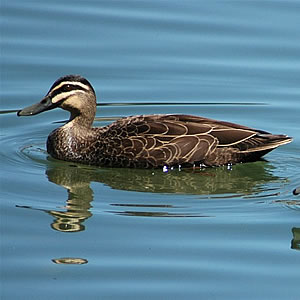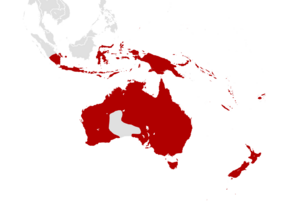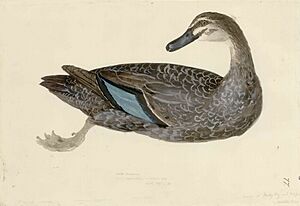Pacific black duck facts for kids
Quick facts for kids Pacific black duck |
|
|---|---|
 |
|
| Conservation status | |
| Scientific classification | |
| Genus: |
Anas
|
| Species: |
superciliosa
|
| Subspecies | |
|
See text |
|
 |
|
| Natural range of the Pacific black duck | |
The Pacific black duck (Anas superciliosa) is a type of duck that lives in water. You can find it in many places like Indonesia, New Guinea, Australia, New Zealand, and islands in the southwestern Pacific Ocean. It reaches as far north as the Caroline Islands and east to French Polynesia. In New Zealand, people often call it the grey duck or by its Maori name, pārera. This duck is known for feeding by dipping its head into the water.
Contents
About the Pacific Black Duck's Name

Scientists officially named the Pacific black duck in 1789. A German naturalist named Johann Friedrich Gmelin gave it the scientific name Anas superciliosa. He put it in the group of ducks called Anas.
The name Anas is a Latin word for "duck." The second part, superciliosa, means "eye-browed" in Latin. This refers to the dark stripe that looks like an eyebrow above the duck's eye.
Gmelin used information from an English bird expert, John Latham. Latham had seen a drawing of the duck by Georg Forster. Forster drew the duck in New Zealand during James Cook's second voyage. This drawing is very important because it was the first official record of the species.
Types of Pacific Black Ducks
Today, scientists recognize two main types, or subspecies, of the Pacific black duck:
- A. s. pelewensis: This type lives on islands in the southwest Pacific and northern New Guinea.
- A. s. superciliosa: This type lives in Indonesia, southern New Guinea, Australia, and New Zealand. In New Zealand, it is known as the grey duck or pārera.
What the Pacific Black Duck Looks Like
This duck likes to live in wet places like swamps and rivers. It has a dark body and a lighter-colored head. There's a dark cap on its head and dark stripes on its face. When it flies, you can see a green patch on its wing. This patch is called a speculum. The underside of its wings is pale.
Both male and female ducks look very similar. They are usually between 54 and 61 centimeters long. Males are often a bit bigger than females. Some ducks living on islands are smaller and darker than those in other areas.
Like its relatives, the mallard and American black duck, the female Pacific black duck can make a loud, fast quacking sound. This sound gets quieter as she finishes.
Life Cycle and Behavior
Reproduction
Pacific black ducks usually build their nests in holes in trees. Sometimes, they might use an old nest made by a crow or similar bird. Occasionally, they will even build a nest on the ground.
The female duck lays about 8 to 10 pale cream-colored eggs. Only the female sits on the eggs to keep them warm. The eggs hatch after about 26 to 32 days. The baby ducklings are born with soft downy feathers and can move around soon after hatching. The mother duck takes care of them. They can fly when they are about 58 days old.
What They Eat
The Pacific black duck mainly eats plants. It especially likes the seeds of water plants. Sometimes, it also eats small crustaceans, molluscs, and water insects.
They find their food by 'dabbling'. This means the duck puts its head and neck underwater. Its rear end sticks straight up out of the water. Sometimes, they also look for food on land in wet, grassy areas.
Conservation Status
The number of Pacific black ducks has gone down a lot in New Zealand and some Australian islands. This is mainly because of the mallard duck, which was brought to these areas by people.
Mallards are bigger and stronger than Pacific black ducks. They also mate with Pacific black ducks, creating mixed-breed ducks. This means that over time, there are fewer pure Pacific black ducks. Scientists are worried that the Pacific black duck might lose its unique identity as a separate species. This problem is also happening in many parts of Australia.
Images for kids
See also
- Dalvirus anatis






